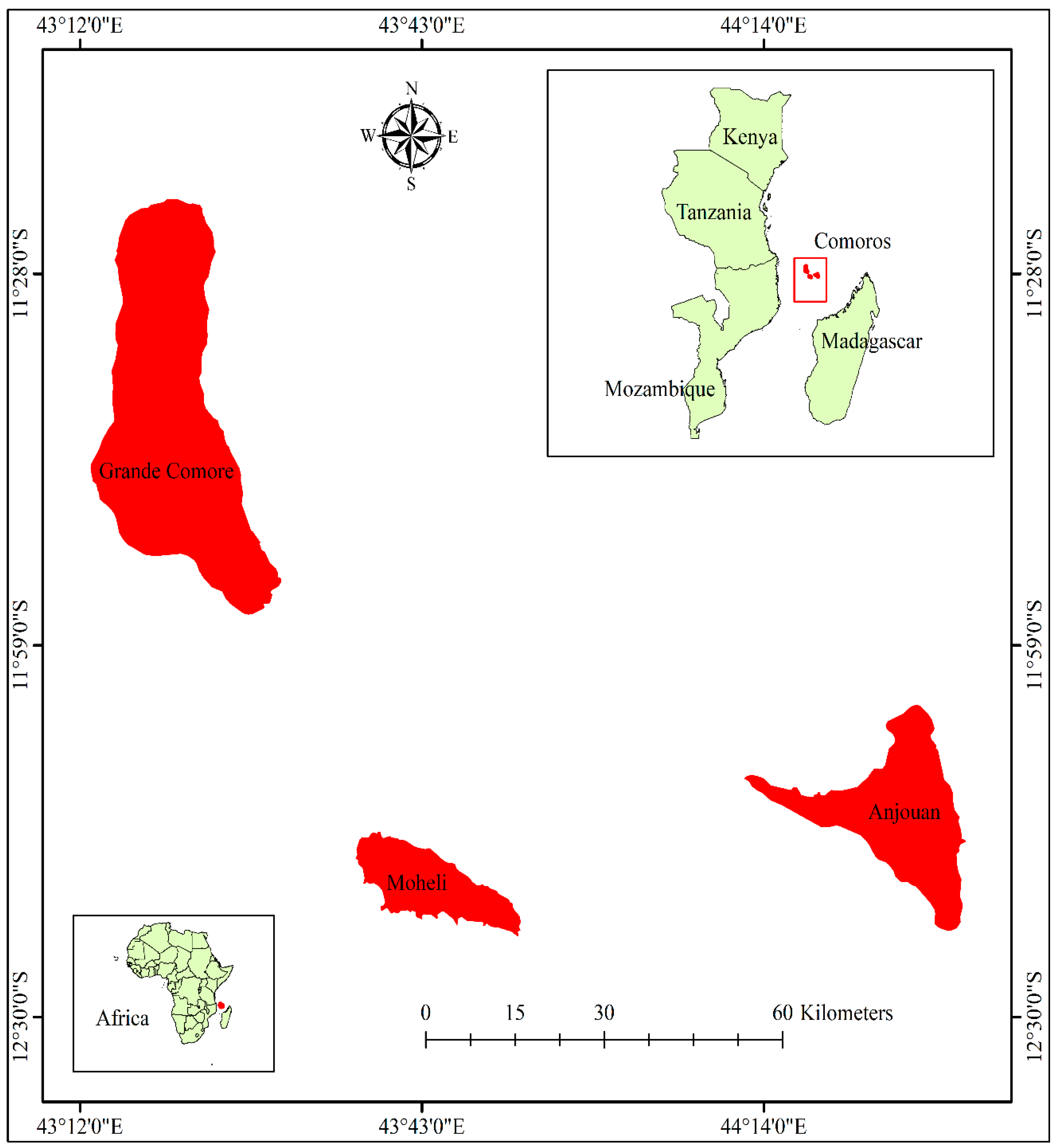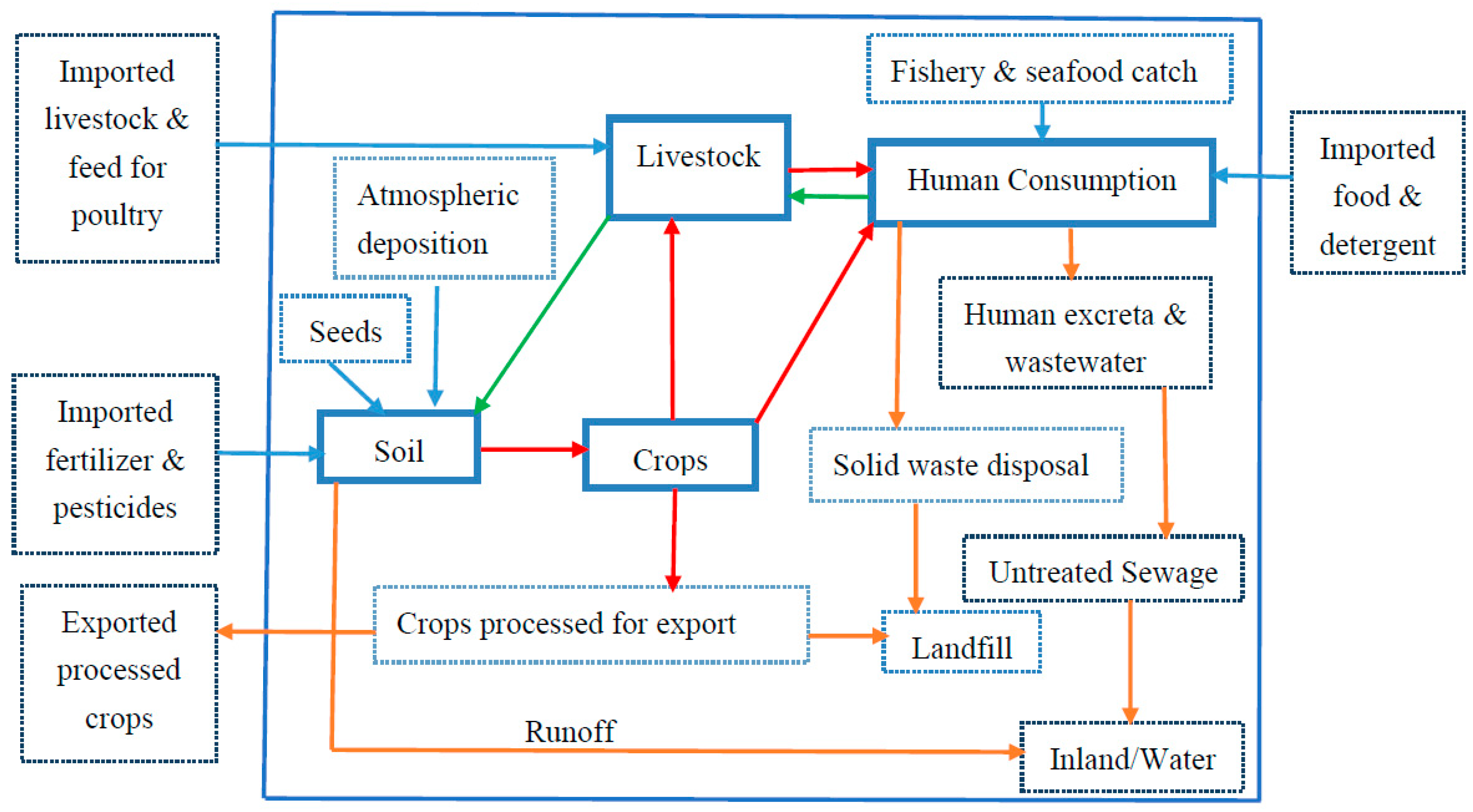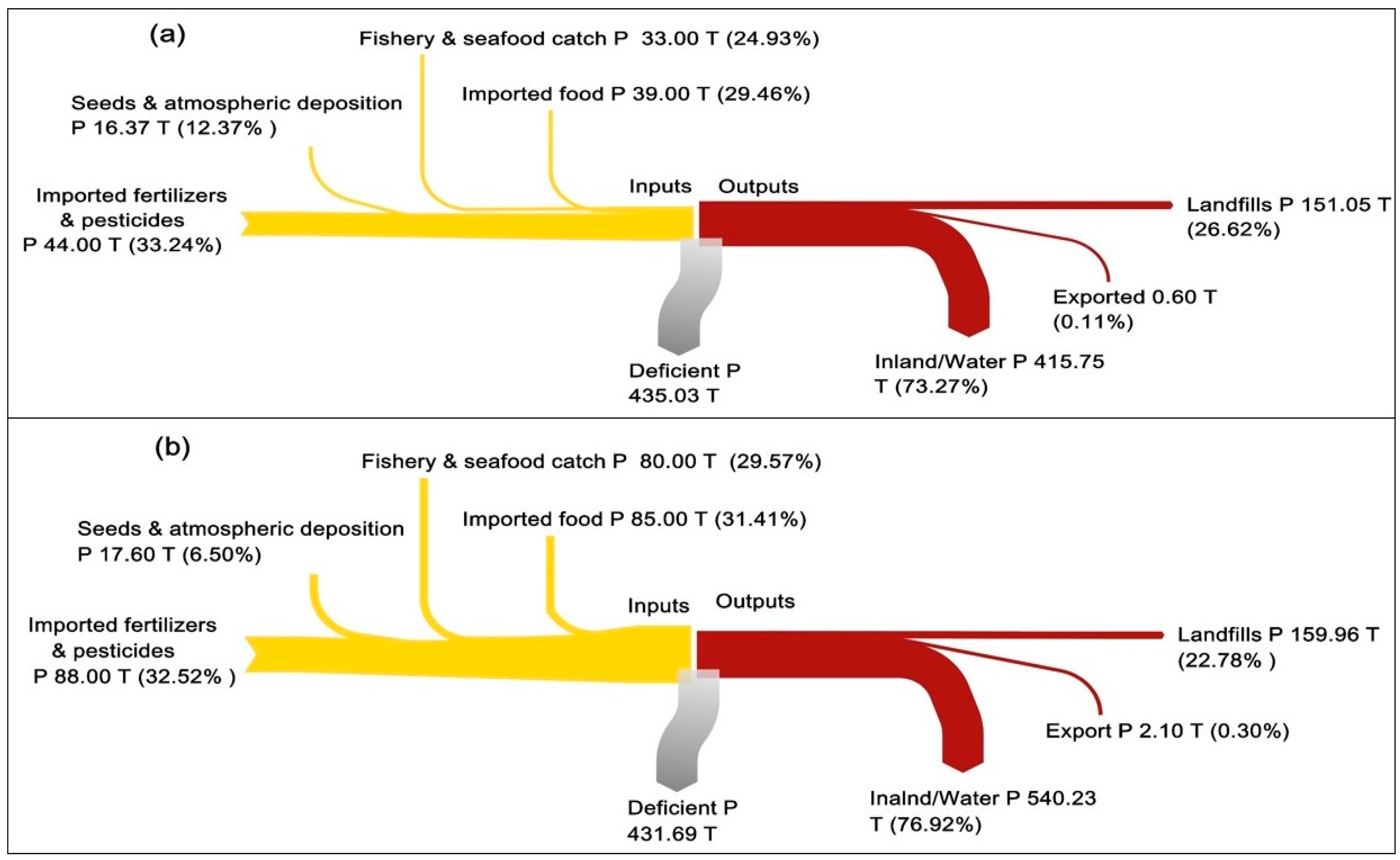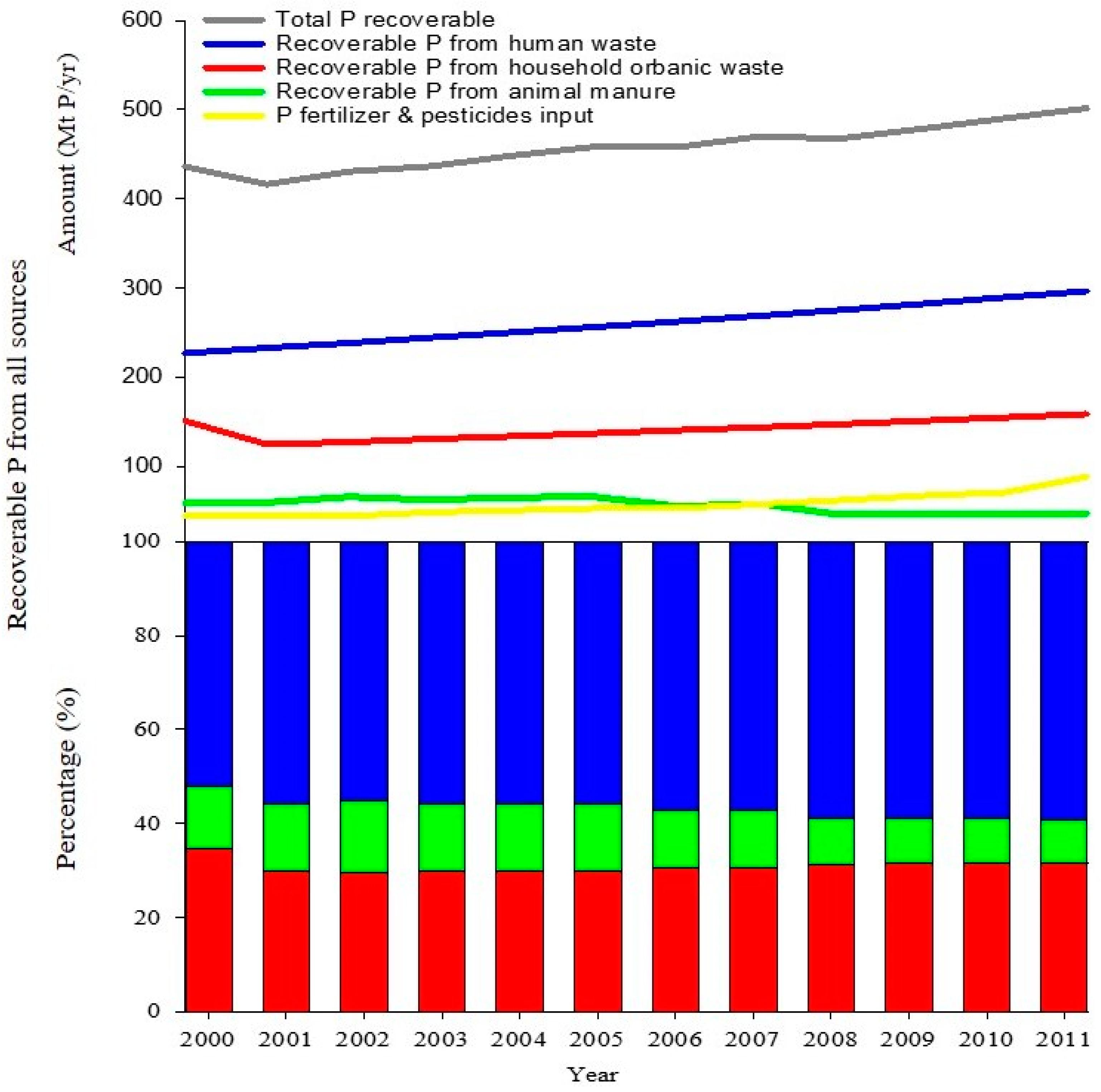Food Phosphorus Flows in a Low-Income, Food- and Phosphorus-Deficient Country
Abstract
1. Introduction
2. Materials and Methods
2.1. Description of the Study Area
2.2. Phosphorus-Flow Analytical Model
2.3. Calculation Methods
2.3.1. P Concentration
2.3.2. Soil P Deficiency
2.3.3. PUE in Plant and Animal Production
2.4. Data Sources
3. Results
3.1. Overall Comorian P Metabolisms
3.2. P Flows in the Subsystems
3.3. PUE in Animal and Plant Production
4. Discussion
4.1. Recovery of P for Improving PUE in Comoros
4.2. Agricultural Production Subsystem and Soil P Deficiency in Comoros
5. Conclusions
Supplementary Materials
Author Contributions
Funding
Acknowledgments
Conflicts of Interest
References
- USGS. Phosphate Rock Statistics and Information. 2010. Available online: http://minerals.usgs.gov/minerals/pubs/mcs/2009/mcsapp2009.pdf (accessed on 3 September 2018).
- Cordell, D.; Drangert, J.; Stuart White, S. The story of phosphorus: Global food security and food for thought. Glob. Environ. Change 2009, 19, 292–305. [Google Scholar] [CrossRef]
- Sattari, S.Z.; Bouwman, A.F.; Giller, K.E.; Van Ittersum, M.K. Residual soil phosphorus as the missing piece in the global phosphorus crisis puzzle. Proc. Natl. Acad. Sci. USA 2012, 109, 6348–6353. [Google Scholar] [CrossRef]
- FAO. World Fertilizer Trends and Outlook to 2020. 2015. Available online: http://www.fao.org/3/a-i6895e.pdf (accessed on 2 January 2018).
- Oliveira, M.; Machado, A.V. The role of phosphorus on eutrophication: A historical review and future perspectives. Environ. Technol. Rev. 2013, 2, 117–127. [Google Scholar] [CrossRef]
- Kitsiou, D.; Karydis, M. Coastal marine eutrophication assessment: A review on data analysis. Environ. Int. 2011, 37, 778–801. [Google Scholar] [CrossRef] [PubMed]
- Seitzinger, S.; Mayorga, E. Chapter 7.3: Nutrients Inputs from River Systems to Coastal Waters. In IOC-UNESCO and UNEP (2016). Large Marine Ecosystems: Status and Trends; United Nations Environment Programme: Nairobi, Kenya, 2016; pp. 179–195. [Google Scholar]
- Nyenje, P.M.; Foppen, J.W.; Uhlenbrook, S.; Kulabako, R.; Muwanga, A. Eutrophication and nutrient release in urban areas of sub-Saharan Africa—A review. Sci. Total Environ. 2010, 408, 447–455. [Google Scholar] [CrossRef] [PubMed]
- Smil, V. Phosphorus in the Environment: Natural Flows and Human Interferences. Ann. Rev. Energy Environ. 2000, 25, 53–88. [Google Scholar] [CrossRef]
- Steen, I. Phosphorus availability in the 21st Century: Management of the non-renewable resource. Phosphorus Potassium 1998, 217, 25–31. [Google Scholar]
- Cordell, D.; White, S. Life’s Bottleneck: Sustaining the World’s Phosphorus for a Food Secure Future. Annu. Rev. Environ. Resour. 2014, 39, 161–188. [Google Scholar] [CrossRef]
- Obersteiner, M.; Peñuelas, J.; Ciais, P.; Van der Velde, M.; Janssens, I.A. The phosphorus trilemma. Nature Geosci. 2013, 6, 897–898. [Google Scholar] [CrossRef]
- Van der Velde, M.; See, L.; You, L.; Balkovič, J.; Fritz, S.; Khabarov, N.; Obersteiner, M.; Wood, S. Affordable Nutrient Solutions for Improved Food Security as Evidenced by Crop Trials. PLoS ONE 2013, 8, E60075. [Google Scholar] [CrossRef] [PubMed]
- Vlek, P.L.G. The Role of Fertilizers in Sustaining Agriculture in Sub-Saharan Africa; International Fertilizer Development Center-Africa (IFDC-Africa), B.P. 4483: Lomb, Togo, 1990; p. 327. [Google Scholar]
- Druilhe, Z.; Barreiro-Hurle, J. Fertilizer Subsidies in Sub-Saharan Africa. 2012. Available online: http://www.fao.org/3/a-ap077e.pdf (accessed on 12 January 2016).
- World Bank. Comoros Agricultural Sector Memorandum. 1984. Available online: http://documents.worldbank.org/curated/en/559711468246336466/pdf/multi-page.pdf (accessed on 20 September 2018).
- Document de Stratégie de Croissance et de Réduction de la Pauvreté; Commissariat General au Plan: Moroni, Union Des Comores, 2005; Available online: https://www.comores-online.com/mwezinet/projets/images/dscrprevise101005.pdf (accessed on 10 February 2017).
- Document de Stratégie de Croissance et de Réduction de la Pauvreté; Commissariat General au Plan: Moroni, Union Des Comores, 2009; Available online: http://extwprlegs1.fao.org/docs/pdf/com149192.pdf (accessed on 17 January 2017).
- FAO. Comoros and FAO: Partnering for Sustainable Agricultural Development and Food and Nutrition Security. 2015. Available online: http://www.fao.org/3/a-ax422e.pdf (accessed on 7 November 2017).
- NIP. National Implementation Plan for the Stockholm Convention. Moroni: Stockholm Convention on the Persistent Organic Pollutants (POPs). 2006. Available online: https://www.google.com/url?sa=t&rct=j&q=&esrc=s&source=web&cd=1&ved=2ahUKEwixi9upi-3hAhVT-WEKHWYWCyAQFjAAegQIAhAB&url=http%3A%2F%2Fchm.pops.int%2FPortals%2F0%2Fdownload.aspx%3Fd%3DUNEP-POPS-NIP-Comoros-1.English.pdf&usg=AOvVaw2awOgX7QXltaGbsSmTxX06 (accessed on 11 January 2017).
- Webeck, E.; Matsubae, K.; Nakajima, K.; Nansai, K.; Nagasaka, T. Phosphorus Flows in the Asian Region. Glob. Environ. Res. 2015, 19, 9–17. [Google Scholar]
- Ott, C.; Rechberger, H. The European phosphorus balance. Resour. Conserv. Recycl. 2012, 60, 159–172. [Google Scholar] [CrossRef]
- Antikainen, R.; Lemola, R.; Nousiainen, J.I.; Sokka, L.; Esala, M.; Huhtanen, P.; Rekolainen, S. Stocks and flows of nitrogen and phosphorus in the Finish food production and consumption system. Agric. Ecosys. Environ. 2005, 107, 287–305. [Google Scholar] [CrossRef]
- Neset, S.T.-S.; Bader, H.-P.; Shneidegger, R.; Lohm, U. The flow of phosphorus in food production and consumption-Linköping, Sweden, 1870-2000. Sci. Total Environ. 2008, 396, 111–120. [Google Scholar] [CrossRef] [PubMed]
- Matsubae-Yokoyama, K.; Kubo, H.; Nakajima, K.; Nagasaka, T. A Material Flow Analysis of Phosphorus in Japan. J. Ind. Ecol. 2009, 13, 687–705. [Google Scholar] [CrossRef]
- Ghani, L.A.; Mahmood, N.Z. Balance Sheet for Phosphorus in Malaysia by SFA. Aust. J. Basic Appl. Sci. 2011, 5, 3069–3079. [Google Scholar]
- Cooper, J.; Carliell-Marquet, C. A substance flow analysis of phosphorus in the UK food production and consumption system. Resour. Conserve. Recycl. 2013, 74, 82–100. [Google Scholar] [CrossRef]
- Li, B.; Boiarkina, I.; Young, B.; Yu, W. Substance flow analysis of phosphorus within New Zealand and comparison with other countries. Sci. Total Environ. 2015, 527, 483–492. [Google Scholar] [CrossRef]
- Senthilkumar, K.; Nesme, T.; Mollier, A.; Pellerin, S. Conceptual design and quantification of phosphorus flows and balances at the country scale: The case of France. Glob. Biogeochem. Cycles 2012, 26, GB2008. [Google Scholar] [CrossRef]
- Seyhan, D. Country-scale phosphorus balancing as a base for resources conservation. Resour. Conserv. Recycl. 2009, 53, 698–709. [Google Scholar] [CrossRef]
- Yuan, Z.; Liu, X.; Wu, H.; Zhang, L.; Bi, J. Anthropogenic phosphorus flow analysis of Lujiang County, Anhui province, Central China. Ecol. Model. 2011, 222, 1534–1543. [Google Scholar] [CrossRef]
- Thitanuwat, B.; Polprasert, C.; Englande, A.J., Jr. Quantification of phosphorus flows throughout the consumption system of Bangkok Metropolis, Thailand. Sci. Total Environ. 2015, 542, 1106–1116. [Google Scholar] [CrossRef] [PubMed]
- Yuan, Z.; Shi, J.; Wu, H.; Zhang, L.; Bi, J. Understanding the anthropogenic phosphorus pathway with substance flow analysis at the city level. J. Environ. Manag. 2011, 92, 2021–2028. [Google Scholar] [CrossRef] [PubMed]
- Li, S.; Yuan, Z.; Bi, J.; Wu, H. Anthropogenic phosphorus flow analysis of Hefei City, China. Sci. Total Environ. 2010, 408, 5715–5722. [Google Scholar] [CrossRef] [PubMed]
- Qiao, M.; Zheng, Y.-M.; Zhu, Y.-G. Material flow analysis of phosphorus through food consumption in two megacities in northern China. Chemosphere 2011, 84, 773–778. [Google Scholar] [CrossRef] [PubMed]
- Cui, S.; Xu, S.; Huang, W.; Bai, X.; Huang, Y.; Li, G. Changing urban phosphorus metabolism: Evidence from Longyan city, China. Sci. Total Environ. 2015, 536, 924–932. [Google Scholar] [CrossRef] [PubMed]
- RGPH. Recensement Général de la Population et de l’Habitat des Comores. 2003. Available online: http://www.inseed.km/ (accessed on 2 February 2018).
- International Trade Centre. Ylang-Ylang oil—A Review of production from Comoros. 2015. Available online: http://www.intracen.org/uploadedFiles/intracenorg/Content/Exporters/Market_Data_and_Information/Market_information/Market_Insider/Essential_Oils/Monthly%20report%20August%202015.pdf (accessed on 3 November 2017).
- FAO. Project d’appui à la Commercialisation Produits Agricoles-Promotion des filières Prioritaires et des Activités Structurantes Innovantes. 2005. Available online: http://www.fao.org/3/a-af206f.pdf (accessed on 12 December2018).
- Brunner, P.H.; Rechberger, H. Practical Handbook of Material Flow Analysis. Int. J. Life Cycle Assess. 2004, 9, 337–378. [Google Scholar] [CrossRef]
- Banque Centrale des Comores (BCC). Rapport Annuel, 2005. 2005. Available online: http://www.banque-comores.km/DOCUMENTS/Rapport_annuel_2005.pdf (accessed on 12 January 2016).
- World Health Organization (WHO). Country Cooperation Strategy—Comoros. 2016. Available online: https://apps.who.int/iris/bitstream/handle/10665/137153/ccsbrief_com_en.pdf;jsessionid=05CECE3C79C38D3B5BA70C01095BE672?sequence=1) (accessed on 15 November 2018).
- Komakech, A.J.; Banadda, N.E.; Kinobe, J.R.; Kasisira, L.; Sundberg, S.; Gebresenbet, G.; Vinnerås, B. Characterization of municipal waste in Kampala, Uganda. J. Air Waste Manag. Assoc. 2014, 64, 340–348. [Google Scholar] [CrossRef] [PubMed]
- Motesharezadeh, B.; Etesami, H.; Bagheri-Novair, S.; Amirmokri, H. Fertilizer consumption trend in developing countries vs. developed countries. Environ. Monit. Assess. 2017, 189, 103. [Google Scholar] [CrossRef]
- Dahari. Rapport Annuel 2014. 2015. Available online: https://daharicomores.org/wp-content/uploads/2015/04/Dahari-rapport-annuel-2014.pdf (accessed on 15 February 2019).
- FAO. L’irrigation en Afrique en Chiffres-Enquête AQUASTAT. 2005. Available online: http://www.fao.org/nr/water/aquastat/countries_regions/COM/COM-CP_fra.pdf (accessed on 2 November 2017).





© 2019 by the authors. Licensee MDPI, Basel, Switzerland. This article is an open access article distributed under the terms and conditions of the Creative Commons Attribution (CC BY) license (http://creativecommons.org/licenses/by/4.0/).
Share and Cite
Kamal, T.S.; Huang, Y.; Huang, C.; Xu, S.; Bing, G.; Cui, S. Food Phosphorus Flows in a Low-Income, Food- and Phosphorus-Deficient Country. Agronomy 2019, 9, 212. https://doi.org/10.3390/agronomy9050212
Kamal TS, Huang Y, Huang C, Xu S, Bing G, Cui S. Food Phosphorus Flows in a Low-Income, Food- and Phosphorus-Deficient Country. Agronomy. 2019; 9(5):212. https://doi.org/10.3390/agronomy9050212
Chicago/Turabian StyleKamal, Thabiti Soudjay, Yunfeng Huang, Chulong Huang, Su Xu, Gao Bing, and Shenghui Cui. 2019. "Food Phosphorus Flows in a Low-Income, Food- and Phosphorus-Deficient Country" Agronomy 9, no. 5: 212. https://doi.org/10.3390/agronomy9050212
APA StyleKamal, T. S., Huang, Y., Huang, C., Xu, S., Bing, G., & Cui, S. (2019). Food Phosphorus Flows in a Low-Income, Food- and Phosphorus-Deficient Country. Agronomy, 9(5), 212. https://doi.org/10.3390/agronomy9050212



